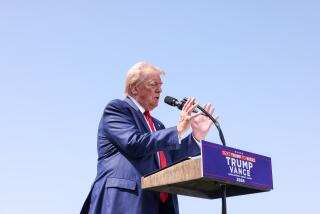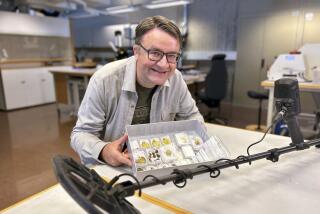Ailing Collector to Sell Rare U.S. Gold Coins : Auctions: Ed Trompeter says his heirs wouldn’t know what to do with the 600 unblemished pieces. They may bring up to $20 million.
- Share via
For the past 20 years, Ed Trompeter of Thousand Oaks has quietly assembled what many consider the world’s finest collection of United States proof gold coins--which are among the rarest and most beautiful coins ever produced in this country.
But Trompeter, 72, who became wealthy by developing electronic equipment that was later used in the Patriot missile, has cancer and his doctors have predicted he has less than a year to live. So he is selling the entire collection in two auctions--the first this month--which are expected to bring in $15 million to $20 million.
“When you get 72, nothing matters when you have cancer or a debilitating disease,” Trompeter said in a telephone interview after one of his twice-daily chemotherapy treatments. “I hate to lose my collection, but the time has come to say bye-bye.”
Trompeter said his heirs--including two daughters and three grandchildren--wouldn’t know what to do with his coin collection.
“If my children had those coins and walked in to a dealer, he would probably rip them off,” Trompeter said.
What makes the Trompeter collection of 600 19th-Century and early 20th-Century coins so unusual is that none were ever circulated and they are virtually free of blemishes, thus the proof quality. In some cases only 10 coins were minted, usually as presentation pieces for senators and presidents, or as patterns for coins intended for general circulation. Others were produced exclusively for collectors attracted by the mirror-like surface and depth of detail unique to proof coins.
“It is one of the great collections of the 20th Century,” said Beth Deisher, editor of Sidney, Ohio-based Coin World, the world’s largest circulation weekly publication for coin collectors.
“It takes years of research to find out about these coins, and sometimes they never become available during a collector’s lifetime. It’s a very significant personal achievement that he was able to put together this collection.”
The upcoming Trompeter auctions have transfixed the coin-collecting community, which hasn’t seen a U.S. gold-coin sale of such importance since the 1982 auction of the famed Louis Eliasberg collection, which fetched more than $11.4 million.
The first Trompeter auction takes place next Tuesday at the Regent Beverly Wilshire Hotel in Beverly Hills, and its organizers--Superior Galleries in Beverly Hills--expect bidders to shell out more than $4 million. The second auction is to be held in November and Superior expects it to raise $11 million to $15 million.
Superior expects to take in $2 million to $3 million in fees from the auctions. The company, which co-president Larry Goldberg said is the highest-volume coin auction house in the United States, makes its money on 10% commissions charged to buyers and sellers. For example, a buyer would pay $1,100 for a coin for which he bid $1,000 while the seller would get $900, for a $200 gross profit to Superior.
Superior is 51% owned by Los Angeles Kings owner Bruce McNall, himself an avid collector of coins and sports memorabilia.
The Trompeter sale, Goldberg said, is expected to be the second- or third-highest grossing coin auction in U.S. history.
Probably the most valuable Trompeter coin is a proof gold $20 coin known as ultra-high-relief, minted in 1907. The coin was produced during the presidency of Teddy Roosevelt, who launched a campaign to upgrade the quality of the nation’s coin supply.
Trompeter bought the coin in 1980 for $200,000, but it should sell for $1 million to $1.5 million when it is auctioned in November, said William Conroy, chief numismatist at Superior.
The coin’s unusual thickness allowed designer and sculptor Augustus Saint-Gaudens to craft it with exceptional detail--the front features Lady Liberty holding a torch and an olive branch; the back has an intricately designed double-eagle pattern. But because of all the work involved in producing the coin, only 24 were minted, and today 15 are accounted for, according to Superior Galleries.
Also up for auction is Trompeter’s so-called complete metric set, believed to be the only set of its kind in existence.
The metric coins, which are imprinted with their gold weight, were proposed in the 1870s as part of an international effort to adopt an interchangeable currency to facilitate trade. The $10 piece, for example, gives the coin’s gold value in six European currencies. The idea never caught on in the United States, and only a few examples of each design were minted.
But the prototypes are among the finest in Trompeter’s collection. “That set of coins, to me, is fantastic,” he said.
For 10 years, Trompeter scoured auctions and private-party sales before he completed the metric set in 1988. It includes four $4 coins, an 1874 $10 gold--one of two known to exist--and an 1879 $20 coin, which is considered the finest of four known pieces.
Trompeter said he became interested in coin collecting in the early 1970s when he spent Sundays attending swap meets where collectors traded everything from stamps to guns. He soon started collecting old business strike coins--which were minted for general circulation--but he became disenchanted by unscrupulous dealers.
After doing some research, Trompeter settled on proof gold coins. “I’ve always aspired to getting the best coins I could,” he said. “Proofs were the best, I decided. They were rare, the quantity was known, and they weren’t messed with.”
It helped that Trompeter had the means to be choosy. A native of New York City, Trompeter served as a radioman on the aircraft carrier Enterprise during World War II, then left the military and joined the Federal Communications Commission’s television division. He later worked as a civilian at the Point Mugu Naval Air Missile Test Center.
Combining his knowledge of television and missile testing technology, Trompeter formed Trompeter Electronics Inc. in Westlake Village, which he sold two years ago for an undisclosed sum. The company, with current annual sales of about $22 million, specializes in digital electronic connectors that are used to relay information in television stations, Boeing Co. aircraft, AT&T; telephone systems and the Patriot missiles used during the Persian Gulf War.
Until recently, Trompeter rarely displayed his gold coins, which he kept in individual envelopes tucked away in a bank vault.
“In today’s world, it’s not safe out there, whether you have a wristwatch or a $200-million collection,” Trompeter said. “It’s a bad world.”


